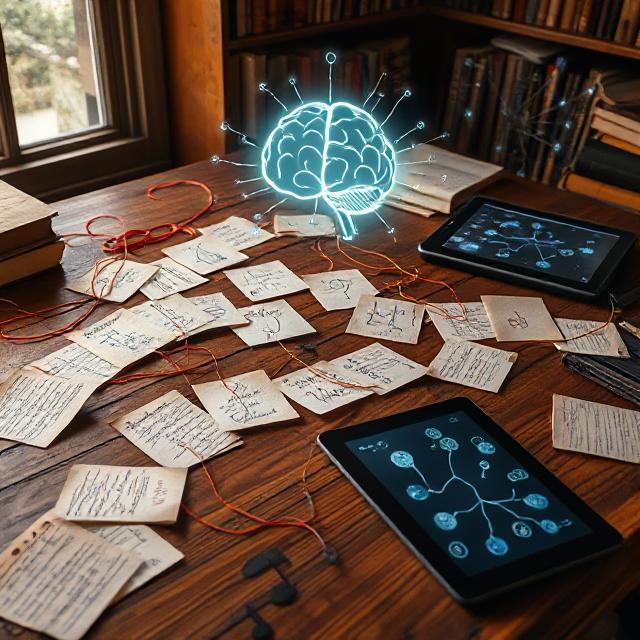
Table of Contents
Using Zettelkasten for Syntopic Idea Tracking
The Zettelkasten method—German for “slip box”—was designed by sociologist Niklas Luhmann to track ideas, link concepts, and generate insights. But its power multiplies when merged with syntopic learning. Why? Because both systems thrive on interconnection, iteration, and personal synthesis.
Zettelkasten is not just a note-taking method. It’s a thinking system. And when applied to syntopic learning—where you integrate multiple viewpoints around a theme—it becomes a tool to track evolving insight across disciplines with precision and flexibility.
This article explores how to adapt Zettelkasten to fuel syntopic learning, helping you retain more, think deeper, and build networks of thought that evolve as you do.
🧠 What Is the Zettelkasten Method?
At its core, the Zettelkasten is a system of atomic notes:
- One idea per note
- Each note gets a unique ID or address
- Notes are linked to related ideas
- New notes are continuously added and cross-referenced
Luhmann reportedly created over 90,000 such notes—each one connected to others—and used them to write over 70 books and 400 articles.
Rather than storing information by topic (e.g., “psychology” or “nutrition”), Zettelkasten stores by conceptual relationship. This allows for unexpected connections, much like how the brain forms neural networks.
🧠 How It Enhances Syntopic Learning
Syntopic learning asks: What happens when I compare multiple ideas across sources and perspectives?
Zettelkasten answers: Let’s keep track of those comparisons and turn them into insight.
Together, they do three key things:
- Force reflection – Instead of copying notes, you rewrite them in your own words.
- Create synthesis – Linking ideas reveals patterns and contradictions.
- Fuel ideation – Revisiting your note network over time sparks new questions and frameworks.
✍️ Setting Up a Syntopic Zettelkasten System
You can use paper index cards, digital apps (Obsidian, Logseq, Notion), or hybrid formats. What matters is consistency, connection, and clarity.
📁 1. Create Three Core Note Types:
- Literature Notes:
Direct takeaways from books, lectures, podcasts. Always in your own words.
Example:Note ID: L23a
Title: Dopamine as Prediction, Not Pleasure
Summary: Schultz’s research reframed dopamine as a reward prediction mechanism, not a reward signal itself. Useful for understanding motivation in productivity. - Permanent Notes:
Synthesized insights that connect to other ideas.
Example:Note ID: P23f
Title: Anticipated Effort Regulates Focus More Than Reward
Links to: [L23a], [P17d]
Insight: When we expect challenge (effort), our brain activates focused attention networks—even if the reward is distant or vague. - Index/Structure Notes:
Maps of topics you’re exploring syntopically. Think of these as tables of contents or knowledge trees.
Example:Note ID: S23m
Title: Motivation Models Across Cultures
Links: [P23f], [P18b], [L20k], [P12a]
🔁 Example: Syntopic Exploration of “Focus”
Let’s say you’re studying focus across psychology, productivity, and neurobiology.
You might create:
L15z: Summary of “Deep Work” by Cal NewportL16c: Notes from a dopamine podcast with Dr. Andrew HubermanP16h: Synthesis note—Focus is trainable via reward prediction, not environment removalP16i: Comparison—Eastern vs Western views of attentional disciplineS16a: Structure note—”Cognitive Focus: Systems, Rituals, Brainwaves”
Linking Ideas:
P16hconnects toL15z(environment design) andL16c(dopamine timing)P16ilinks to earlier philosophy notes about meditation, Taoism, and monastic learning- You realize: Focus isn’t just a skill—it’s a culturally shaped cognitive framework
This web of notes becomes an idea engine. Not a dead archive.
📚 Using Zettelkasten to Track Syntopic Themes
Use your Zettelkasten to manage evolving syntopic questions. For example:
Topic: Nutrition and Brain Function
Questions you track:
- How do different cultures approach brain nutrition?
- What molecular mechanisms link food and cognition?
- What are critiques of mainstream nutritional neuroscience?
Over time, your notes link:
- Citations from biochemistry papers
- Observations from fasting experiments
- Traditional medicine insights
- Personal reflections from diet changes
This becomes a living latticework—constantly updated, layered, and more useful with age.
🧩 Practical Workflows for Daily Use
Daily (15–30 min):
- Add 1–3 literature notes from today’s reading/podcasts
- Turn 1 into a permanent note
- Link 1–2 older notes into the new insight
Weekly (45–60 min):
- Review structure notes (by theme)
- Consolidate threads into a visual map or summary post
- Flag areas needing deeper reading
Monthly:
- Export insights into a blog, essay, or teaching outline
- Identify gaps or biases in your note network
- Revisit early notes to challenge or expand them
💡 Why It Works for Memory and Insight
Zettelkasten + syntopic learning trains your brain through:
- Elaboration – Encoding meaning through personal framing
- Recursion – Revisiting ideas deepens synaptic strength
- Relational thinking – Memory improves when tied to patterns
- Interleaving – Mixing topics builds generalization
It’s not just data collection. It’s schema refinement over time—a key ingredient in long-term memory formation.
🧠 From Note-Taking to Network Thinking
Traditional notes:
🗒️ One-time info capture → Forgotten in a week
Zettelkasten + Syntopic:
🧠 Interconnected ideas → Revisited, revised, synthesized over time
You shift from memorizing to internalizing
From following others to constructing your own system
🧭 Final Thought: Your Brain Is a Network. Build It Like One.
Syntopic learners don’t just collect ideas—they link them, test them, and evolve them.
Zettelkasten gives you the scaffolding to do that. It turns fragmented learning into an organized constellation of understanding. And with every connection you make, you not only remember more—you become more original.
Use Zettelkasten not just to record thoughts…
But to grow a brain outside your brain.